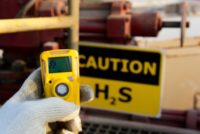No safety technology is changing as fast as that employed in PPE. The devices of just a few years ago are now obsolete by replacements that are lighter, easier to use, and more protective. These resources alert you to developments in the field, and equally important, supply training ideas to get your workers to use their PPE, and use it correctly.
Free Special Report: Does Your PPE Program Meet OSHA’s Requirements?
For those performing tasks in high-risk industries, personal protective equipment, or PPE, is their last line of defense. It’s important to be as informed as possible about all of the PPE necessary to performing a job safely, but you may have some questions about the proper uses of flame resistant (or FR) garments within your […]
On our latest episode of the EHS on Tap podcast, an expert answered some big questions about the proper uses of flame resistant (FR) garments within a personal protective equipment (PPE) program. Read the transcript of our conversation with Derek Sang, Technical Training Manager for Bulwark FR.
Wearable technology could alert construction workers to nearby vehicles or equipment, preventing caught between and struck-by injuries, a recent study found. A prototype belt with vibrating motors alerted participants to the presence of vehicles and equipment in research performed by CPWR—The Center for Construction Research and Training.
A California appeals court upheld the citation of Home Depot USA, Inc., for violating state safety standards after a warehouse employee suffered a serious foot injury.
Are your workers and business protected against the potential dangers of hydrogen sulfide (H2S) exposure? It may surprise you that subjection to the toxic “sour” gas remains one of the leading causes of workplace gas inhalation deaths, and OSHA recently cited a Texas employer after H2S exposure in a confined space resulted in a fatality. There […]
When an employer provides personal protective equipment (PPE) to all onsite workers (including contractors and subcontractors), does it have any liability or exposure if the PPE fails? Does the fact of whether the PPE was provided for free come into play? This question was recently posed to experts at Safety.BLR.com®—read on to see their response.
The National Institute for Occupational Safety and Health (NIOSH) has released a new virtual toolkit to help first responders reduce their exposure to fentanyl and other illicit drugs. The toolkit provides resources to help keep first responders safe when arriving on a scene where illicit drugs, including fentanyl, are present or suspected to be present.
On September 26, OSHA added two new protocols for ensuring employees’ respirators fit properly. When employers are required under personal protective equipment regulations to provide respiratory protection, they also are required to ensure the respirators properly fit each employee.
Personal protective equipment (PPE) is vital to workplace safety, but it can also be uncomfortably hot—and warm weather doesn’t help. New research and products are looking to keep workers cool while wearing PPE without compromising on protection.
Hard hats have become the PPE that is particularly emblematic of safety, and head protection systems are evolving to meet the needs of modern workers. Read the transcript of our recent conversation with Chris Cota and Aaron Skemp from Ergodyne®, where we took a special look at the most recent developments in head protection.










